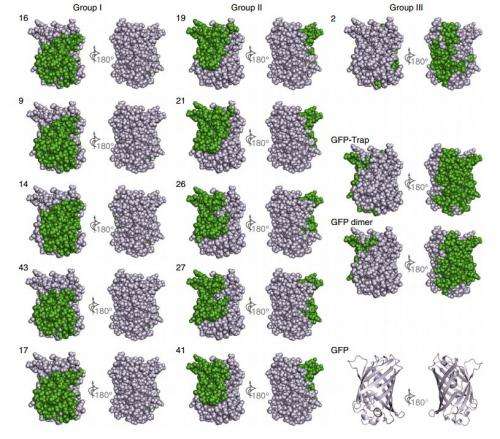New technique efficiently turns antibodies into highly tuned 'nanobodies'

Antibodies, in charge of recognizing and homing in on molecular targets, are among the most useful tools in biology and medicine. Nanobodies – antibodies' tiny cousins – can do the same tasks, for example marking molecules for research or flagging diseased cells for destruction. But, thanks to their comparative simplicity nanobodies offer the tantalizing prospect of being much easier to produce.
Unfortunately, their promise hasn't been fully realized, because scientists have lacked an efficient way of identifying the nanobodies most closely tuned to their targets. However, a new system, developed by researchers at Rockefeller University and their collaborators and described today in Nature Methods, promises to make nanobodies dramatically more accessible for all kinds of research.
Antibodies are defensive proteins deployed by the immune system to identify and neutralize invaders. But their power can be harnessed in other ways as well, and they are used in biology and medicine for visualizing cellular processes, attacking diseased cells and delivering specific molecules to specific places. Like their larger cousins, nanobodies can also be used for these tasks but their small size makes nanobodies much easier to grow in bacterial factories. They can also access hard to reach places that may be off limits to larger molecules.
"Nanobodies have tremendous potential as versatile and accessible alternatives to conventional antibodies, but unfortunately current techniques present a bottleneck to meeting the demand for them," says study author Michael Rout, head of the Laboratory of Cellular and Structural Biology at Rockefeller. "We hope that our system will make high-affinity nanobodies more available, and open up many new possible uses for them."
In their first studies, the team generated high-affinity antibodies, those that are capable of most precisely binding to their targets, directed against two fluorescent proteins that biologists often use as markers to visualize activity within cells: GFP and mCherry. Their new system, like existing ones for generating antibodies, begins with an animal, in this case llamas housed in a facility in Connecticut.
Llamas were chosen because the antibody variants they produce are easily modified to generate nanobodies, which are only one-tenth the weight of a regular antibody. The llamas were immunized with GFP and mCherry, prompting their immune systems to generate antibodies against these foreign proteins.
"The key was to figure out a relatively fast way of determining the genetic sequences of the antibodies that bind to the targets with the greatest affinity. Up until now obtaining these high-affinity sequences has been something of a holy grail," says Brian Chait, Camille and Henry Dreyfus Professor and head of the Laboratory of Mass Spectrometry and Gaseous Ion Chemistry at Rockefeller. "Once those sequences are obtained, it's easy to engineer bacteria to mass produce the antibodies."
The researchers, led by graduate student Peter Fridy and postdoc Yinyin Li, started by making antibody sequence databases from RNA isolated out of antibody-producing cells in the llamas' bone marrow. Next, they picked out the tightest binding GFP and mCherry antibodies from blood samples from the same llamas, and chemically cut these into smaller pieces, keeping only the antigen-binding section to create nanobodies.
They then determined partial sequences of the amino acids that made up the protein of the nanobodies with a technique known as mass spectrometry. Using a computer algorithm called "llama magic," developed by David Fenyö and Sarah Keegan of New York University School of Medicine, they matched up the composition of the highest affinity nanobodies with the original RNA sequence. With this sequence, they could engineer bacteria to mass produce the nanobodies before putting them to use in experiments.
Antibodies are often used to isolate a particular structure within a cell so scientists can remove and examine it, and the team did just that with their new nanobodies. They purified various cellular structures tagged with GFP or mCherry, and also visualized these structures in situ.
All in all, their procedure generated 25 types of nanobodies capable of precisely targeting GFP and six for mCherry, a far more diverse set of high affinity nanobodies than is typically possible with conventional techniques.
This abundance opens up new options. Scientists can select only the best ones, eliminating nanobodies that by chance cross-react with other molecules, or string together two nanobodies that attach to different spots on the same target molecule to generate a super-high-affinity dimer, exactly as the researchers demonstrated for the GFP nanobodies. This super-high-affinity could be a powerful feature when delivering therapeutic or diagnostic molecules because it would lower the required dosage, and so reduce unwanted side effects.
"Given that we can now readily identify suites of high affinity nanobodies, the future for them as research tools, diagnostics and therapeutics looks bright," says Rout.
More information: A robust pipeline for rapid production of versatile nanobody repertoires, Nature Methods, DOI: 10.1038/nmeth.3170
Journal information: Nature Methods
Provided by Rockefeller University
















